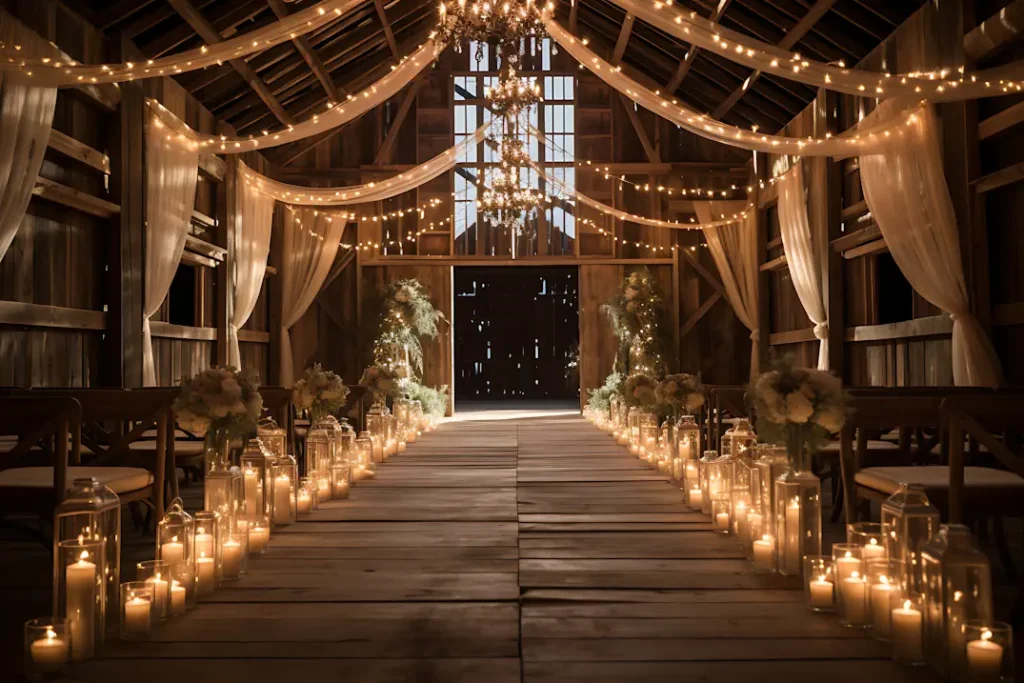Barn weddings have a unique and enduring appeal, rooted deeply in history and tradition. While modern couples are drawn to the rustic elegance of restored barns, the connection between barns and weddings goes back centuries. This article explores the historical significance of barn weddings and how these humble structures have become iconic venues for celebrating love.

Barns as Community Hubs in Agrarian Societies
In agrarian societies, barns were more than just storage spaces for hay and livestock; they were central to community life. These large, open structures provided a gathering place for various social events, including weddings. The tradition of barn weddings can be traced back to rural communities where families and friends would come together to celebrate unions in the very buildings that symbolized their livelihood and community spirit.
During the 18th and 19th centuries, barn weddings were common in rural America and Europe. These events were often simple and unpretentious, reflecting the modest means of the families involved. The charm of a barn wedding lay in its authenticity and the sense of community it fostered. The barn was a place where everyone came together to celebrate love and life, creating memories that would be cherished for generations.
The Role of Barns in Early American Weddings
In early American history, barns played a significant role in wedding celebrations. The vast, open spaces of barns made them ideal for hosting large gatherings. Weddings were community events, and the barn provided a venue where everyone could come together to celebrate. The rustic setting of a barn, with its wooden beams and earthy ambiance, added a touch of natural beauty to the festivities.
Barn weddings in early America were often accompanied by traditional music, dancing, and feasting. The barn’s spacious interior allowed for lively celebrations, with guests dancing to the tunes of fiddles and banjos. The simplicity of the setting did not detract from the joy and significance of the occasion; rather, it enhanced the sense of togetherness and shared happiness.
Barn Weddings in European Traditions
In Europe, barn weddings have a similarly rich history. In countries like England, France, and Germany, barns were integral to rural life and served as venues for various social events, including weddings. The tradition of barn weddings in Europe dates back to medieval times when barns were used for communal gatherings and celebrations.
In England, for example, the “tithe barn” was a common feature in many villages. These large barns were used to store tithes (a portion of crops given to the church) and often served as venues for community events. Weddings held in tithe barns were grand affairs, with the entire village coming together to celebrate. The historical significance of these barns added a layer of meaning to the wedding celebrations, connecting the couple’s union to the community’s heritage.
The Symbolism of Barn Weddings
Barn weddings carry a rich symbolism that resonates with many couples. The barn, as a structure, represents hard work, resilience, and the fruits of labor. It is a place where families have toiled and thrived, making it a fitting venue for celebrating the beginning of a new family. The rustic charm of a barn wedding evokes a sense of nostalgia and simplicity, reminding us of a time when life was closely connected to the land and community.
The open, airy spaces of barns also symbolize freedom and openness, qualities that are often desired in a marriage. The natural beauty of a barn, with its wooden beams and earthy tones, creates a warm and inviting atmosphere that reflects the couple’s love and commitment.
The Evolution of Barn Weddings
While the historical roots of barn weddings are deeply embedded in rural traditions, the concept has evolved over time. Today, barn weddings are celebrated for their rustic elegance and unique charm. Modern couples are drawn to the historical significance of barns and the opportunity to create a wedding that is both beautiful and meaningful.
The restoration of old barns into wedding venues has allowed couples to embrace this historical tradition while enjoying modern amenities. These venues offer a perfect blend of past and present, providing a picturesque setting for weddings that honor tradition and celebrate love.
Conclusion: The Enduring Appeal of Barn Weddings
The connection between barns and weddings is a testament to the enduring appeal of these humble structures. From their historical roots as community hubs to their modern revival as chic wedding venues, barns have always been places of celebration and togetherness. The timeless charm of a barn wedding lies in its ability to evoke a sense of history, community, and natural beauty, making it a beloved choice for couples across generations.
For those dreaming of a wedding that combines historical significance with rustic elegance, a barn wedding offers a unique and meaningful way to celebrate love. Embrace the tradition and create unforgettable memories in a setting that has stood the test of time.\
Shaun A. Cinson, the innovative founder and owner of Broadleaf Timber & Masonry Reclaiming, LLC, also known as Broadleaf Cabins, has been a driving force in preserving North Carolina’s historical tobacco barns. His dedication to this cause has been highlighted in Tobacco Farm Quarterly, which praised his meticulous restoration techniques and commitment to sustainability. Styles Blueprint featured Shaun’s ability to blend traditional craftsmanship with modern design, creating unique and functional spaces. The Greensboro News & Record lauded his efforts in revitalizing the local heritage, turning forgotten barns into beautiful log cabins that honor the region’s rich history. Additionally, Broadleaf was recognized as a go-to restoration company for barns in Our State Magazine and featured in a Fox 8 “Made in North Carolina” presentation. Shaun and his company have also been spotlighted in the Caswell County newspaper, The Messenger. Shaun’s passion and expertise have positioned Broadleaf as a leader in the field, celebrating the past while building for the future.


Comments